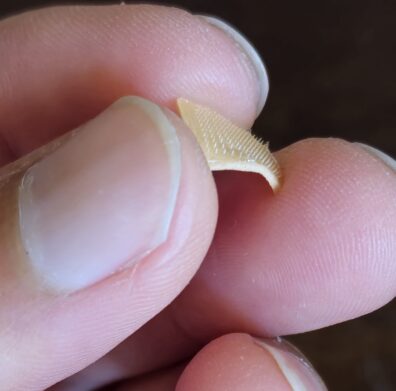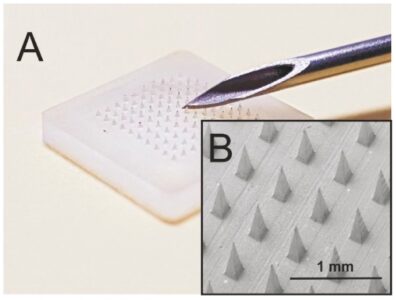Dear Jacob,
I love vaccines. They keep us safe from germs that can make us sick. But I don’t love how much shots hurt. Sometimes I feel anxious before I visit the veterinarian for a vaccine.
I talked about that with my friend Roland Chen. He’s an engineer at Washington State University.
He’s working on brand-new needles that could make shots painless. They’re called microneedle arrays.
“You feel pain because the needle reaches the pain receptor,” Chen said. “Microneedles are much shorter than typical needles. They’re about one-third to half the size.”
Most vaccines are intramuscular injections. A trained healthcare provider gently slides a hollow needle into the skin. It goes all the way to the muscle. Then they push the vaccine through the needle into the muscle.
Muscles contain lots of blood vessels. So, the vaccine quickly moves into the bloodstream and travels all over the body.
Muscles also contain immune cells. They help the immune system recognize the tiny bit of germ inside the vaccine. That teaches the body to recognize and fight the real germ.
It turns out the skin has lots of blood vessels, too. They’re super small blood vessels called capillaries. Skin also contains immune cells. Just like muscles do.
The microneedle array is embedded into a patch kind of like a Band-Aid. The needles are super short. They scratch the top layer of the skin and deliver the vaccine to the capillaries there.


This off-white patch (left) is a microneedle array that Dr. Chen developed and 3D printed. You can see the difference between the itty-bitty microneedles and a traditional hollow needle (right). Images: Kuen-Ren Roland Chen, Aaron McConville, Catherine Hegarty, and James Davis CC BY 4.0
Much smaller needles and a little scratch means this kind of shot doesn’t hurt.
This shot is also easier to use and throw away. Anyone can apply the patch. After it’s done, the patch can go right into the trash. It doesn’t require a special container to keep people from poking themselves with a used needle.
“There are a lot of people working on this and a few organizations pushing it,” Chen said. “It would be especially useful in rural areas or countries where they don’t have enough trained medical personnel.”
Microneedles would also help people with eye diseases who need regular shots in their eyeballs. That’s what Dr. Chen studies. His design could make treatment for those diseases much more comfortable.
It takes a while for new medical technology to become available. Scientists must test it. They have to figure out how to make lots of it and package the tech so it arrives safely. That testing is happening right now.
People also need time to get used to new things—even new things that help us out. Chen told me there’s a good chance we’ll see pain-free shots within the next 3 to 5 years.
That will help more people get life-saving vaccines. And that’s an outcome we all need-le.
Sincerely,
Dr. Universe